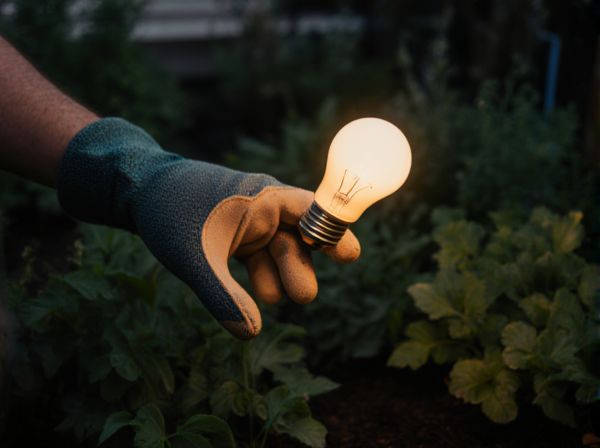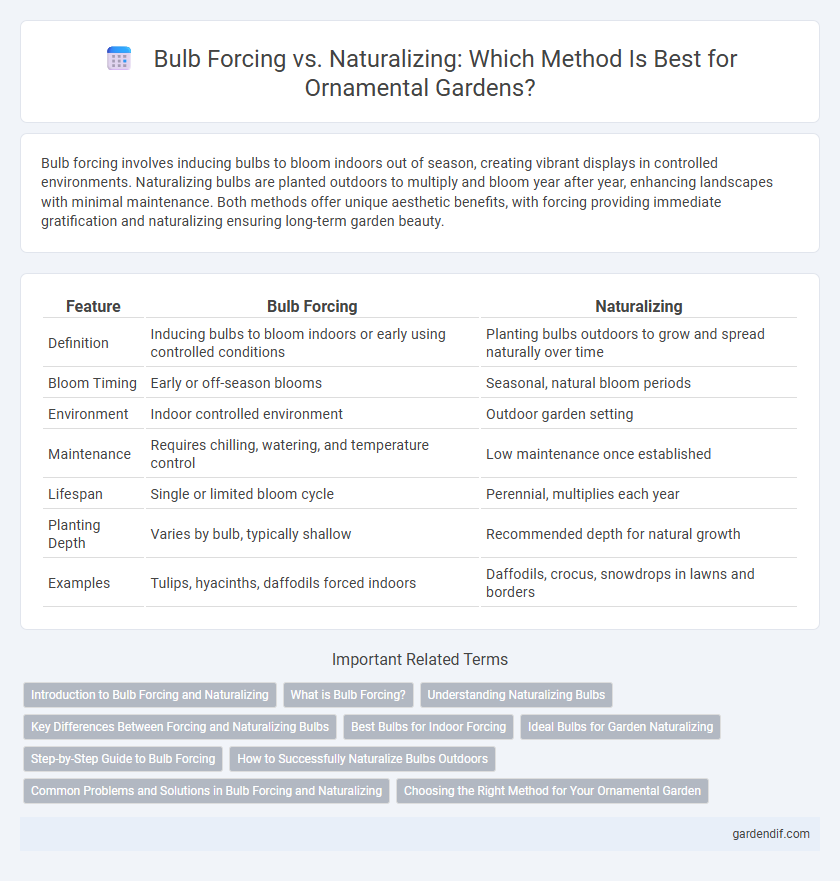
Bulb Forcing vs Naturalizing Illustration
Bulb forcing involves inducing bulbs to bloom indoors out of season, creating vibrant displays in controlled environments. Naturalizing bulbs are planted outdoors to multiply and bloom year after year, enhancing landscapes with minimal maintenance. Both methods offer unique aesthetic benefits, with forcing providing immediate gratification and naturalizing ensuring long-term garden beauty.
Table of Comparison
| Feature | Bulb Forcing | Naturalizing |
|---|---|---|
| Definition | Inducing bulbs to bloom indoors or early using controlled conditions | Planting bulbs outdoors to grow and spread naturally over time |
| Bloom Timing | Early or off-season blooms | Seasonal, natural bloom periods |
| Environment | Indoor controlled environment | Outdoor garden setting |
| Maintenance | Requires chilling, watering, and temperature control | Low maintenance once established |
| Lifespan | Single or limited bloom cycle | Perennial, multiplies each year |
| Planting Depth | Varies by bulb, typically shallow | Recommended depth for natural growth |
| Examples | Tulips, hyacinths, daffodils forced indoors | Daffodils, crocus, snowdrops in lawns and borders |
Introduction to Bulb Forcing and Naturalizing
Bulb forcing involves manipulating temperature and light conditions to induce early blooming of bulbs like tulips and daffodils indoors, creating vibrant floral displays ahead of the natural season. Naturalizing allows bulbs to adapt and multiply over time in outdoor gardens, producing sustainable and spontaneous flower growth year after year. Understanding the differences between bulb forcing and naturalizing helps gardeners decide whether to enjoy immediate indoor blooms or establish lasting outdoor landscapes.
What is Bulb Forcing?
Bulb forcing is a horticultural technique that stimulates flower bulbs to bloom indoors or out of their natural season by manipulating temperature and light conditions. This process mimics winter dormancy, followed by a controlled warm period to induce accelerated growth and flowering. Bulb forcing enables gardeners to enjoy early blooms and extend the ornamental display of tulips, daffodils, and hyacinths beyond their typical naturalizing cycles.
Understanding Naturalizing Bulbs
Naturalizing bulbs are perennial plants that adapt to garden conditions, multiplying and spreading year after year without replanting. Unlike forcing bulbs, which require specific indoor conditions to bloom quickly, naturalizing bulbs thrive outdoors, enhancing landscapes with minimal maintenance. Species such as daffodils, crocuses, and snowdrops are ideal for naturalizing due to their hardiness and ability to naturalize natural ecosystems.
Key Differences Between Forcing and Naturalizing Bulbs
Bulb forcing involves planting bulbs indoors or in controlled environments to induce early blooming, optimizing growth conditions like temperature and light for quicker flower development. Naturalizing bulbs are planted outdoors in natural settings where they multiply and bloom year after year without human intervention, adapting to local climate and soil. The key differences lie in timing control--forcing accelerates bloom cycles--while naturalizing emphasizes sustainability and perennial growth in plant habitats.
Best Bulbs for Indoor Forcing
Hyacinths, tulips, and daffodils are among the best bulbs for indoor forcing due to their rapid growth and vibrant blooms that brighten interior spaces. Forcing bulbs indoors requires pre-chilling them to mimic winter conditions, ensuring strong root development and timely flowering. Choosing bulbs labeled specifically for forcing guarantees higher success rates compared to naturalizing varieties adapted for outdoor growth.
Ideal Bulbs for Garden Naturalizing
Ideal bulbs for garden naturalizing include species such as daffodils, crocuses, and snowdrops, known for their ability to multiply and spread naturally over time. These bulbs thrive in established garden beds and woodland areas, requiring minimal maintenance while providing long-lasting spring blooms. Selecting naturalizing bulbs with strong bulbs and naturalizing habits ensures sustainable growth and enhances the garden's perennial beauty year after year.
Step-by-Step Guide to Bulb Forcing
Bulb forcing offers a controlled environment to bloom flowers like tulips and daffodils indoors during winter, contrasting with naturalizing that relies on outdoor seasonal cycles. Begin by selecting healthy bulbs with firm scales, then chill them at 35-48degF (1.5-9degC) for 12-16 weeks to simulate winter dormancy necessary for proper root development. Pot bulbs in well-drained soil, water sparingly, and place them in indirect light, gradually moving to brighter conditions as shoots emerge to ensure vibrant, early blooms.
How to Successfully Naturalize Bulbs Outdoors
Successfully naturalizing bulbs outdoors involves selecting species that thrive in local climates and planting them in well-drained soil where they can multiply year after year. Bulbs such as daffodils, snowdrops, and crocuses are ideal for naturalizing due to their hardiness and ability to spread naturally without disturbance. Proper timing of planting in the fall, along with minimal maintenance, supports the bulbs' natural growth cycle and enhances garden biodiversity over time.
Common Problems and Solutions in Bulb Forcing and Naturalizing
Bulb forcing often faces challenges like improper chilling periods, leading to weak blooms, while naturalizing struggles with poor soil drainage causing bulb rot. Ensuring bulbs undergo adequate cold treatment and planting in well-drained soil are essential solutions to these problems. Using disease-free bulbs and adjusting planting depth further enhances bulb vitality and flower quality in both forcing and naturalizing practices.
Choosing the Right Method for Your Ornamental Garden
Selecting between bulb forcing and naturalizing depends on desired bloom time and garden design. Bulb forcing allows control over flowering indoors or early in the season, ideal for seasonal displays. Naturalizing suits low-maintenance, long-term garden integration, promoting bulbs to multiply and return year after year in natural settings.
Bulb Forcing vs Naturalizing Infographic

 gardendif.com
gardendif.com